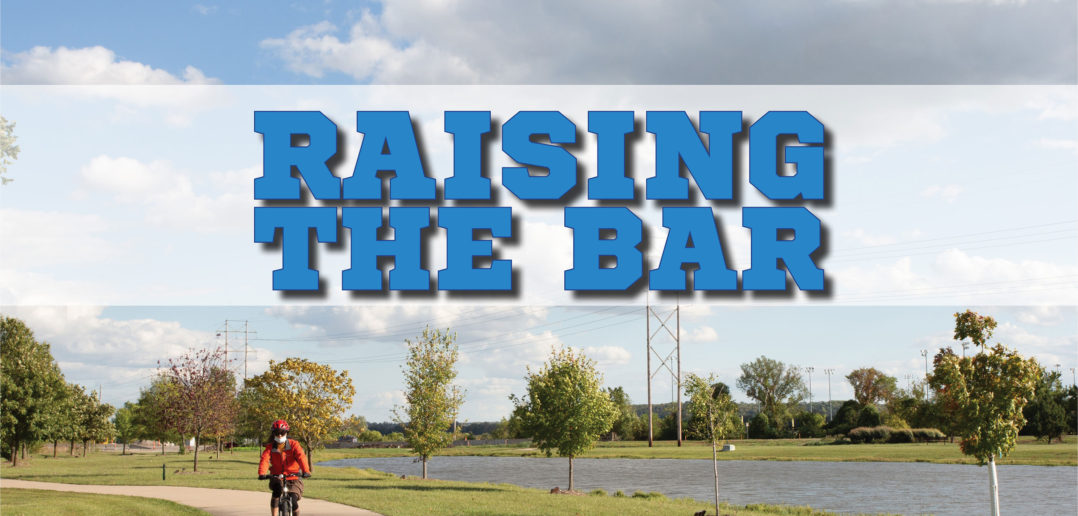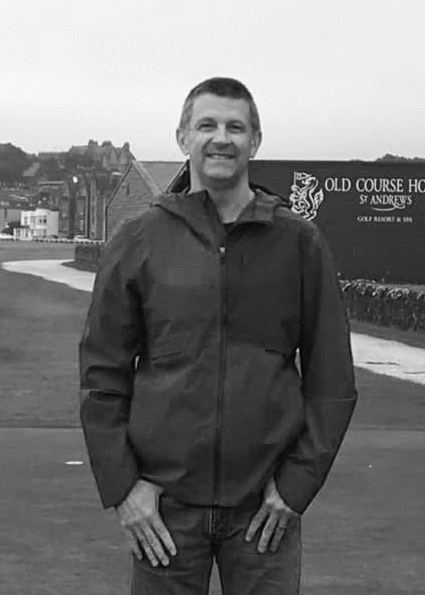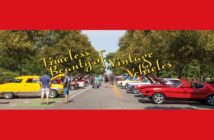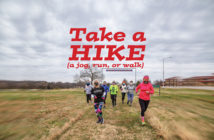The City of Lawrence has plans for a sophisticated network of infrastructure to enhance its multimodal transportation system, which includes bikeways, shared-use paths and safer pedestrian walkways.
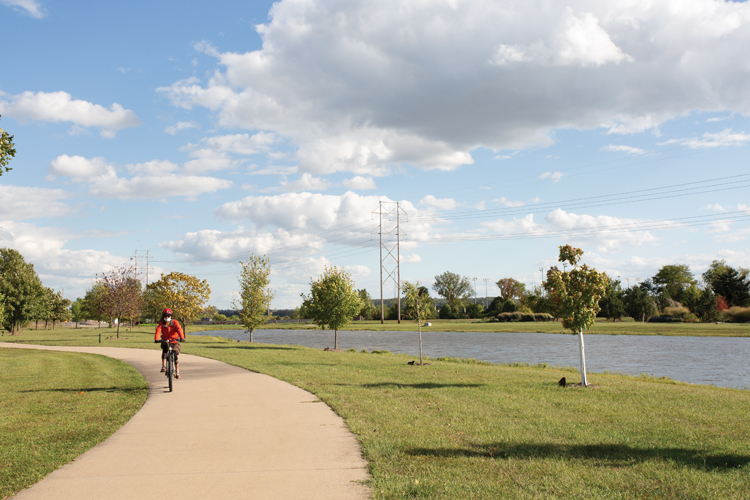
Biking the Lawrence trails on a chilly day
As one of the preeminent college towns in America, Lawrence often prides itself on being a progressive—dare we way hip—place to live and raise a family. It’s not a place that follows the latest movements or fashions. Lawrence sets trends.
However, when it comes to promoting and facilitating transportation in all its alternate forms, such as accessible and safe bicycling, walking, Rollerblading and scootering, there appear to be more practical motives at hand, at least according to one of the city’s transportation experts.
“Studies have shown that peoples’ quality of life is impacted by their transportation choices,” says Jessica Mortinger, transportation planning manager for the Lawrence Metropolitan Planning Organization. “And the reality is that transportation networks provide transportation opportunities and increased access.
“People everywhere want to walk and bike,” she continues. “In the end, we’re all pedestrians, even if it’s just walking to our cars to go to work every morning.”
With that in mind, the City of Lawrence has plans in place and in the works for a sophisticated network of bicycle and pedestrian infrastructure. The multimodal transportation system is roughly broken down into three planning areas: bikeways (this includes the Lawrence Loop, a 17-mile completed section of 8-foot-wide and paved shared-use path that is planned to loop the city), safe routes to school and pedestrian walkways, all interacting and coexisting with one another.
Much of Lawrence’s transportation system already has been constructed, however bicycle and pedestrian connections, and features like tunnels and bridges are being built or at least plan on being built in the near future.
It’s all in the name of making Lawrence a safe place to move around in other ways than a typical, traditional motorized vehicle. If there’s a hipness factor that comes with that, well, all the more reason to get behind the initiative.
“The objective of the Lawrence Bikes Plan,” Mortinger says, “is to focus on design for lower speed and greater comfort. It’s about creating facilities that are comfortable for the greatest number of users.”
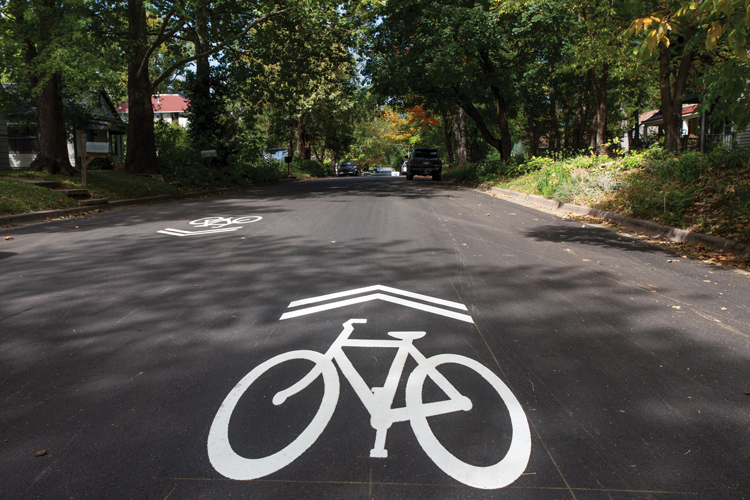
Street bike path designation
BIKEWAYS
Planning for bikeways in Lawrence and Douglas County is not a new concept. The first bike plan for Lawrence was prepared in 1974 and called “Pedal Plan for Lawrence.” The first countywide bicycle plan was developed in 2004. In 2016, the City dedicated funding for bicycle and pedestrian projects.
Previously, planning to improve nonmotorized transportation conditions was set forth in several various plans among different organizations, such as the Lawrence Pedestrian-Bike Issues Task Force, the Lawrence Loop Alignment Study, annual bicycle and pedestrian counts, and a countywide bikeway system plan. The Lawrence Bikes Plan set out to reconcile all those various entities into one cohesive plan for the future of bikeway infrastructure in Lawrence.
The Lawrence Bikes Plan was approved by the City Commission in October 2019. Mortinger explains it set in motion a prioritized plan for multimodal infrastructure, of which bike lanes, shared-use paths and bicycle boulevards were an integral part.
“The plan calls for a comfortable network of bikeways,” she says. “Much of the current bikeway network is shared-use path.”
The centerpiece of the plan is what is known as the Lawrence Loop, a continuous, 22-mile trail around the city limits. David Cronin, city engineer, Municipal Services & Operations, says the Loop is about 75 percent complete. Two stretches in final design phase, not included in the Loop, include a path through Hobbs Park between Eighth and Delaware streets to 11th Street and Haskell Avenue, and a pathway along 29th Street, connecting Burroughs Creek Trail and Haskell Trail. Still in the planning phase is a shared-use path starting at Peterson Road and Iowa Street, tunneling under McDonald Drive and running east to Michigan Street. Construction is scheduled to begin in 2022.
Other recently completed projects include a tunnel project at 19th and Iowa Streets, which allows cyclists and pedestrians safe passage from the University of Kansas’ (KU) West Campus across always-busy Iowa Street to the main campus to the east, bike boulevard on 21st Street between Massachusetts Street and Ousdahl Road, bike lanes on Mass Street between 14th and 11th streets, and shared-use path and bike lanes on Kasold Drive from Bob Billings Parkway to Sixth Street.
“We’re bringing up the bar for people to have those opportunities (to use nonmotorized modes of transportation),” Mortinger says. “It’s safer infrastructure.”
Changing the culture toward nonmotorized forms of transportation also is an important piece of the plan, she continues. To that end, the City has promoted bicycle month (May) and bike-to-work days, and has sponsored bicycle safety education rides and bicycle and pedestrian safety webinars. It also has implemented into its city codes requirements that any new business construction include parking facilities for bicycles. City and KU buses have increased carrying capacities for commuters wishing to truly use multimodal transportation in moving about the city by installing bike racks on the fronts of all buses.
The City’s implementation of bicycle and pedestrian plans appears to be working, at least in the eyes of organizations that recognize municipalities that actively support bicycling. In 2020, the City of Lawrence was designated at the Bronze level by the League of American Bicyclists, renewing the recognition given first in 2004.
The PlacesForBikes City Ratings, a data-driven analysis that evaluates the safety, appeal and infrastructure of bicycling in more than 500 communities, ranked Lawrence sixth overall in 2019 and third in safety in 2020.
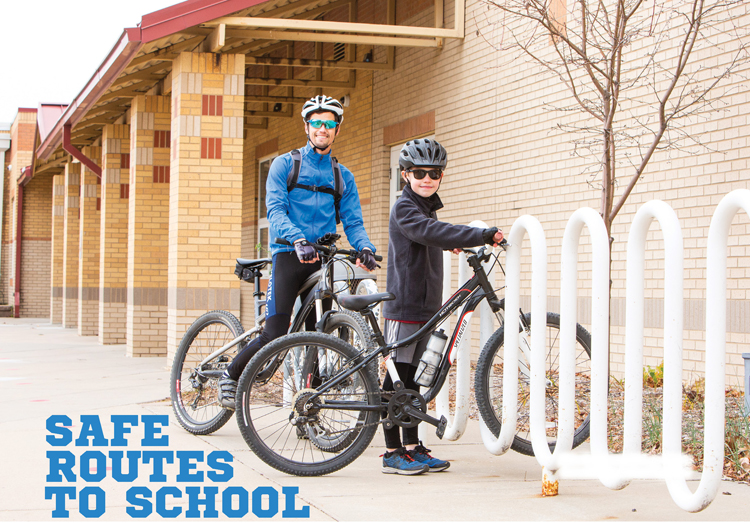
Mike Garven and his son Luke love riding to together
SAFE ROUTES TO SCHOOL
The Lawrence Safe Routes to School (SRTS) initiative began in 2014. It started as a collaborative effort among the City, Lawrence-Douglas County Health Department, Lawrence Public Schools and the Lawrence-Douglas County Metropolitan Planning Organization. The aim of the partnership was to provide the framework for developing a holistic SRTS program, focusing on encouragement, education, enforcement, evaluation and engineering solutions to improve walking and bicycling to school.
Mortinger says the City is in the process of finishing a written SRTS plan, round two of planning work that started six years ago. Funding and financial resources for the project have been harder to come by, she says, but the City has been successful at getting federal grant money for other projects such as the 19th and Iowa tunnel project as well as construction of a new sidewalk on the east side of Naismith Drive from 19th to 23rd streets.
“There are limited resources, so we’ve had to spend wisely,” Mortinger explains. “But we have a network of evaluated routes (in the plan), all data-driven.”
Other aspects of the SRTS plan call for implementing the Neighborhood Traffic Management Program, which includes reducing speed limits to 25 miles per hour in neighborhoods, improving sidewalks and crossings, and making sure all students in Unified School District 497 get bicycle education. There will be promotions for “Bike-and-Walk-to-School Days” and guides for parents to form “walking school buses,” where walking “drivers” walk through neighborhoods picking up students one by one to walk to school as a group.
“We have an obligation to work on cultural changes around walking and biking,” Mortinger says. “A lot has to do with user behavior to ensure streets are safe for everyone.”
In 2009, a study showed that nationally, 13 percent of kids wanted to walk to school. Lawrence stands at 18 percent (that compares with 48 percent in 1969 according to the National Safe Routes to School Partnership).
“I think we can improve that with safer crossings and routes,” Mortinger says, adding that another study showed kids who engage in physical activity make better grades.
“Plans are in the final draft, getting ready for consideration,” she says. “We’re excited about that.”
The partnership also is working in Eudora and Baldwin City to create SRTS plans in those cities.
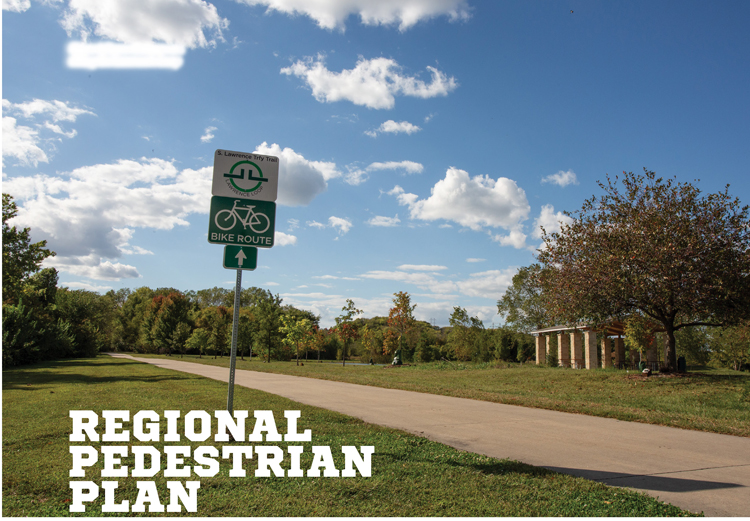
Signs marking the Lawrence Loop
REGIONAL PEDESTRIAN PLAN
“We will be updating our pedestrian plan sometime in the next year,” Mortinger says.
Ironically, the scourge of 2020—more specifically referred to as the worldwide COVID-19 pandemic—has had an effect on pedestrian traffic on Lawrence’s sidewalks and shared-use pathways that might be unexpected. It seems, Mortinger explains, that people are so fatigued at being locked down in their homes, the desire to get outside and move has been higher than normal.
With that in mind, the City has been working diligently not only on building new infrastructure but also repairing Lawrence’s existing sidewalks. In fact, the City is in the second year of its Sidewalk Improvement Program. Ultimately, city engineer Cronin says, it’s up to property owners to maintain sidewalks on their properties, but part of the program helps notify property owners that those needs are met.
“We have filled in a lot of gaps on arterial streets with sidewalk infill,” Cronin says. “We’ve completed a majority of them.
“It’s going to take many years to get sidewalks up to code, but we’re making steps,” he continues. “Next year, we’re going to tailor the program to improve sidewalks that get used the most.”
There are various other initiatives planned as the City moves forward aimed at keeping Lawrence on the cutting edge of multimodal transportation—or to keep the city hip.
Cronin says the city had a bicycle share program operated by a private company, but it proved not to be profitable enough and was pulled off the streets. The City is looking into a shared motorized scooter program and anticipates a pilot program to begin next year.
“There’s certainly more to come in the future,” he explains. “It’s more about how to incorporate everything into our overall approach with the (City’s) Multimodal Transportation Commission.”
![]()

